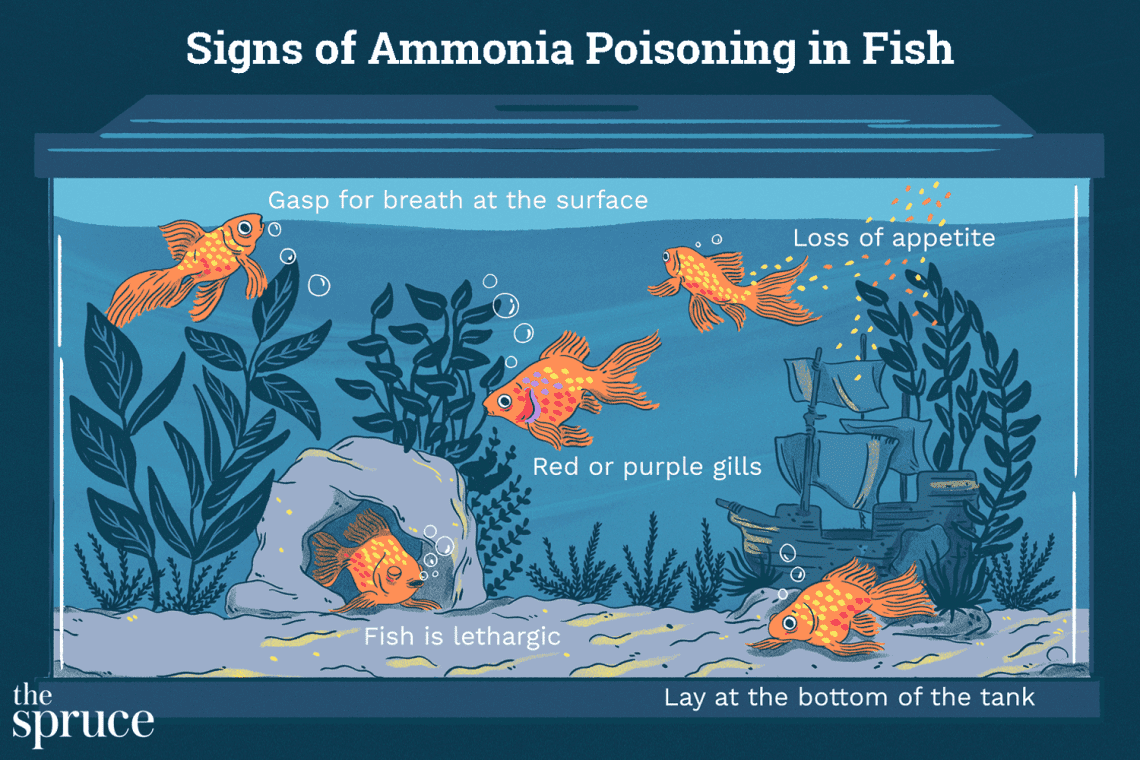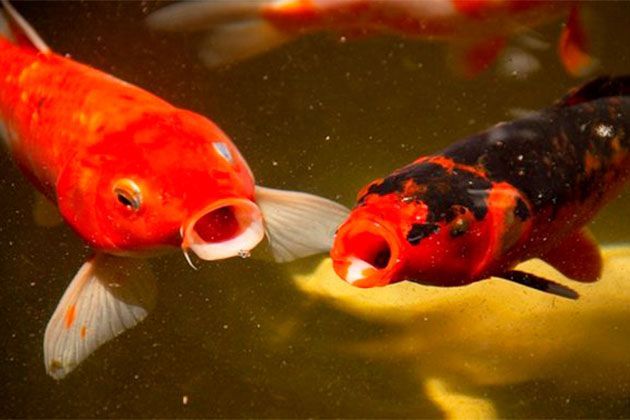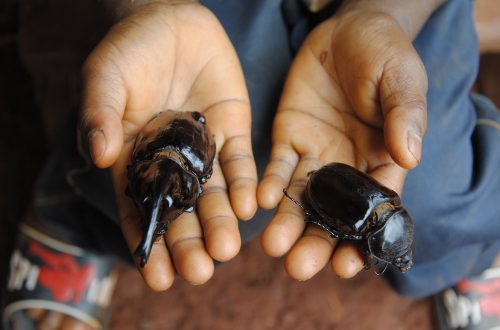
Aquarium fish poisoning

Poisoning of aquarium fish is quite common. But not all owners know about it. Often the general deterioration or death of fish is associated with infectious diseases and time is missed. Thus, you can lose all the inhabitants of the aquarium. How to understand the cause in time and eliminate it – we will tell in this article.
Contents
- Poisonings are divided downstream into acute and chronic.
- Causes
- Nitrite poisoning
- Nitrate poisoning
- Ammonia poisoning
- Chlorine poisoning
- Hydrogen sulfide poisoning
- Gas embolism from excess oxygen
- Poisoning with household chemicals and aerosols
- Chemical poisoning from new equipment and decor
- Metal poisoning
- Medicine poisoning
- Feed poisoning
- Treatment and prevention of poisoning
Poisonings are divided downstream into acute and chronic.
Acute:
- The fish is suffocating and keeps near the surface of the water, or lies on the bottom
- Darkening or discoloration of the gills
- Change in body color – too pale or very dark
- Excessive mucus secretion
- Red spots on the body, fins and gills
- compressed fins
- Loss of coordination, trembling and convulsions
- Fixed, glazed eyes (usually fish can move them)
- Anorexia
- Excessively agitated or lethargic state
- Sudden death
Chronic:
- Prolonged general depression
- unhealthy look
- Lying in dark corners
- Rapid breathing
- Trembling and swaying body movements
- compressed fins
- Weakened immunity, susceptibility to fungal and bacterial diseases
- Excessive mucus secretion
- Unexplained death of fish
Causes
Many substances are poisonous to fish. Some of them – ammonia, nitrites and nitrates – are products of the nitrogen cycle and are formed naturally in the aquarium (nitrogen-containing waste). Other toxic substances can come with tap water, such as chlorine, chloramine, and insecticides, which are used to kill bacteria and invertebrates present in drinking tap water. Heavy metals such as lead and copper are also sometimes present in tap water. Many medicines can be poisonous to fish under certain conditions (for example, in excessive doses, mixed with other medicines, or especially sensitive fish). A common cause of poisonous substances entering the aquarium water is inappropriate aquarium decoration and equipment.
- Metals can form toxic salts when they are in salt or acidic water.
- Stones may contain toxic compounds.
- Stones or plastic or ceramic flower pots immersed in an aquarium as decoration or used for planting aquarium plants can be contaminated with pesticides and fertilizers used in horticulture.
- Many types of plastic release toxic substances when immersed in water. Therefore, only use plastic items specifically designed for aquariums or foodstuffs.
- Paints, varnishes, glues and dyes are poisonous unless they are specifically designed for use in an aquarium.
- Wood, driftwood, varnished or impregnated with solutions can poison those fish that scrape wood, such as chain catfish, gerinocheilus, Siamese algae eaters, and also release hazardous substances into the water.
- Unsuitable plants – including some plants that are sold for planting in an aquarium.
- Fish and crustacean foods, if not properly stored, can sometimes lead to aflatoxin poisoning.
- Paint and varnish fumes, chemicals, tobacco smoke, household insecticides, acaricides, and houseplant antifungals can all enter the water through the surface or through an air pump.
- Soaps, cleaning products and other substances can get into the aquarium along with equipment, decorative items or on hands.
- Toxic substances can form in the aquarium with improper and untimely care, overfeeding, overcrowding, excess organic matter.
Nitrite poisoning
Nitrite (NO2) is formed during the nitrogen cycle and is a breakdown product of ammonia. Nitrites are toxic to fish, but less so than ammonia. Nitrites harm fish by affecting their respiratory system. Through the gills, they enter the bloodstream and there cause the oxidation of hemoglobin. High concentrations of nitrites can cause some of the symptoms of acute poisoning, as well as death from hypoxia. Symptoms of acute nitrite poisoning include rapid breathing; fish stay at the surface of the water and breathe with difficulty. In addition, convulsions are observed, especially in small fish. The gill tissues may change from the normal healthy pink color to an unhealthy color ranging from purple to brown. In a short period of time – from several hours to several days, death can occur. Long-term exposure to slightly elevated concentrations of nitrites, although relatively rare, causes a general deterioration in health and suppression of the immune system, as with other types of chronic poisoning. For treatment, sick fish are transplanted into clean water, or nitrite neutralizing substances are added to the old aquarium. If the fish tolerate salt well, you can add 1 g to the aquarium. table salt (sodium chloride) per 10 liters of aquarium water. This measure will significantly reduce the toxicity of nitrites. Another possibility is to use a matured bio-filter from another tank (if available), which will usually bring the nitrite concentration down to near zero levels in 1-2 days. Prevent nitrite poisoning: take good care of the aquarium, measure the water parameters with tests and maintain zero nitrite levels in the water.
Nitrate poisoning
Nitrates (NO3) are the end product of the nitrogen cycle. Nitrates are less toxic to fish than other products of the nitrogen cycle, and in low concentrations are harmless to fish. However, their levels can increase with poor aquarium care, as well as some plant fertilizers, overcrowding and overfeeding of fish. A high nitrate concentration can be considered an indicator of poor water quality and indicates the need for remedial action. Nitrates have a chronic rather than an acute effect. Prolonged exposure to excess nitrate levels can lead to stunting, chronic stress, general poor health, and unwillingness to reproduce. It can make fish more vulnerable to other diseases. Sudden exposure to nitrates in concentrations much higher than normal causes nitrate shock, which should be considered as acute nitrate poisoning – fish usually fall ill 1-3 days after being introduced into the aquarium, sometimes showing signs of acute poisoning, often on the second or third day of being in the aquarium. “new dwelling”, they are found dead. Fish exposed to nitrates are lethargic, breathe rapidly, gills lighten to pale pink, fins compressed, lack of appetite, pale coloration, and body itching. The nitrate concentration in the aquarium should be constantly measured to ensure that it is within safe limits. Good care of the aquarium, avoidance of overcrowding, reasonable feeding of fish and regular partial water changes, as well as the use of special water products. help avoid problems associated with high nitrate concentrations. Nitrates can be removed from tap water using a reverse osmosis device.
Ammonia poisoning
Ammonia enters the aquarium during the life of the fish themselves. In fish, ammonia is excreted primarily through the gills. It is also produced during the nitrogen cycle. In a closed system such as an aquarium, ammonia can reach toxic concentrations. Signs of ammonia poisoning are shortness of breath, too frequent breathing, convulsions, excessive excitability and activity, red spots on the body, excess mucus. With severe poisoning, the gills are damaged, the color changes from healthy pink to brown, the fish suffocates and dies. Occurs with improper care of the aquarium, overcrowding, overfeeding, a large amount of organic matter, lack of filtration and aeration. Installing a high-quality biological filter in the aquarium, timely cleaning and the correct selection of species and number of inhabitants solve the problem of excess ammonia in the aquarium.
Chlorine poisoning
Chlorine is always present in tap water. If poisoning occurs, then the fish turn pale, up to white, and the gills and body are covered with mucus, red spots appear on the body, movements become chaotic, and death occurs. This happens only when the water does not undergo pre-treatment, but is poured into the fish directly from the tap. For this reason, before planting fish in an aquarium or when replacing, the water must be defended in a container for at least 3-4 days. If, nevertheless, this is not possible, then it is necessary to add to the water or special industrial solutions to neutralize chlorine.
Hydrogen sulfide poisoning
Hydrogen sulfide poisoning occurs when improper care of the aquarium, overfeeding, the accumulation of a large amount of feces or parts of rotting plants. At the bottom, an anaerobic environment is formed in which nitrates are converted to nitrogen. Then proteins and amino acids containing sulfur will undergo destruction. This sulfur will be reduced to hydrogen sulfide, a colorless gas that smells like rotten eggs. The water becomes cloudy, acquires an unpleasant smell of rotten eggs, the soil darkens and acquires black spots. When poisoned with hydrogen sulfide, the fish experience suffocation, and, as a result of a lack of oxygen, they rise to the surface of the water and take atmospheric air into their mouths and / or are near the compressor nozzle or the clean water supply pipe and air from the filter. Naturally, in this case, the fish have rapid breathing, which is clearly visible from the too frequent movement of the gill covers. If the aquarist does not urgently take measures to reduce the level of hydrogen sulfide in the water, then the symptoms of poisoning become even more serious.
In this case, the coordination of movements is disturbed in the fish, they become lethargic, react poorly to external stimuli, then they experience paralysis and death.
It is important to give the fish as much food as they can eat in a few minutes. Feed should not settle to the bottom and decompose there. Remaining food must be removed immediately. In a clean aquarium, decay products of organic matter are immediately oxidized to nitrates. Nitrates, as a result of anaerobic decomposition at the bottom, are converted into harmless nitrogen, which is removed by aeration.
Gas embolism from excess oxygen
Gas embolism in fish appears as small bubbles of gas on and in the body or eyes. As a rule, they do not pose a serious health hazard. However, in some cases, the consequences can be very serious, for example, if the lens of the eye is touched or a bacterial infection begins at the site of a burst bubble. In addition, bubbles can also form on the internal vital organs (brain, heart, liver) and cause sudden death of the fish.
The reason is damage to the filtration system or excessively small bubbles from the compressor spray or filter, which dissolve before they reach the surface. The second reason is the addition of a large amount of cooler water than in the aquarium to the aquarium. In such water, the concentration of dissolved gases is always higher than in warm water. As it heats up, air will be released in the form of those same microbubbles.
Poisoning with household chemicals and aerosols
When washing and cleaning the aquarium, do not use aggressive cleaning agents; the walls of the aquarium can be doused with a 10% soda solution, slight traces of which after such treatment do not have a harmful effect on the fish. In the room in which the aquarium is located, it is not recommended to use any chemicals, in extreme cases, it is necessary to use them as little as possible. This primarily applies to paints, varnishes, solvents, diluted houseplant sprays, insecticides. Any contact of the fish with any possible toxin or poison should be avoided. This also includes disinfectants and insecticides. Tobacco smoke is toxic to fish. It is extremely undesirable to smoke in a room with an aquarium; nicotine has a particularly bad effect on a marine aquarium.
Chemical poisoning from new equipment and decor
Decor items, soils, equipment – filters, hoses, sprayers, especially new ones and questionable quality, can release toxic substances into the water that can cause chronic poisoning in fish. You need to carefully select high-quality decor and equipment that are designed specifically for use in the aquarium.
Metal poisoning
There are many ways for metals to enter the aquarium:
- The presence in tap water of metal salts from natural water sources.
- Metals from water pipes and water tanks, especially from hot water pipes in areas where the water is soft and acidic. In such water, a precipitate of calcium carbonate is not deposited, which forms a barrier between the metal and water, so acidic water often reacts with metals.
- Unsuitable aquarium equipment, including metal-framed tanks that contain salt water, and metal lids that are constantly splashed with salt or acidic water (cause may be too much filtration or aeration and lack of coverslips).
- medicines containing copper.
- Presence of metals in rocks and soil.
Symptoms of metal poisoning can vary. In general, metabolic processes in the body of fish are disturbed, gill filaments are damaged, fry are stunted and often die. To treat sick fish, they are transplanted to another aquarium. In the old one, it is necessary to remove the sources of metals, rinse the soil, plants, decor. Metal salts can be removed by reverse osmosis or made harmless with some special water conditioning products. Do not use copper hot water containers – especially in areas where the water is soft. Before collecting water to add to the aquarium, open a cold water faucet for a few minutes to drain the water that has stagnated in the pipes. Use only equipment suitable for aquarium water and avoid misuse and overuse of medicines containing copper.
Medicine poisoning
It also happens that trying to cure the fish, they only make it worse. Most often, saline solutions, malachite green, formalin, manganese, and antibiotics are used to treat infectious and parasitic diseases. The drugs are dissolved in water, making therapeutic baths. It is necessary to carefully consider the calculation of the dose, which depends on the density of the population, the volume of the aquarium and the type of disease. An overdose of medicines in fish can damage vital organs, and they can die. To avoid this, it is recommended to treat sick fish only in a quarantine aquarium, strictly observe the dosage of drugs, as well as their compatibility. It is not recommended to use different drugs at the same time, as their total effect can produce a negative effect. In case of overdose, it is necessary to replace the water.
Feed poisoning
Fish can be poisoned by both dry and live food. Dry food, if stored incorrectly, can become covered with molds, and when fed with such food, aflatoxin poisoning can occur. Aflatoxin poisoning is not particularly common, but it is quite possible if the aquarist acquires large supplies of food and, after opening the package, stores them in an inappropriate place for this. Live food: live daphnia, cyclops, tubifex, bloodworm, gammarus, etc. often carry with them a serious danger, since they, when kept in natural reservoirs, are polluted with sewage from industrial, municipal and household enterprises, as well as mineral fertilizers and pesticides , accumulate a lot of toxic substances in themselves (the pipe maker is especially dangerous in this regard: an inhabitant of contaminated soil, quite often it can live not only in water bodies, but also in puddles, sewers and even in sewer pipes). At the same time, toxic substances do not cause the death of crustaceans and worms, but accumulate in their bodies in significant quantities. Toxic substances begin to accumulate in the body of fish, causing poisoning, characterized by a violation of the central nervous and digestive systems, which can be fatal for fish. When purchasing food, follow the rules of storage, and if you are feeding live food, buy food from trusted sources.
Treatment and prevention of poisoning
If the exact cause of the poisoning is not known, then the best solution is to transplant the fish into another aquarium with high-quality settled water. Use high-quality items designed specifically for the aquarium for care and decoration, regularly test the water, and also follow the rules for caring for the aquarium.





